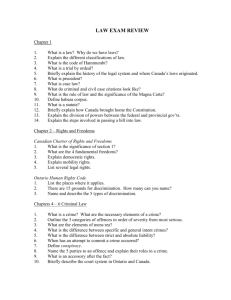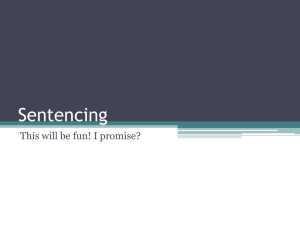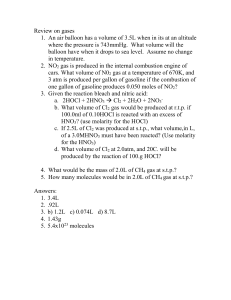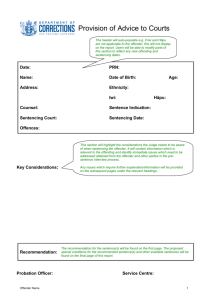community law canterbury - National Association of Community
advertisement
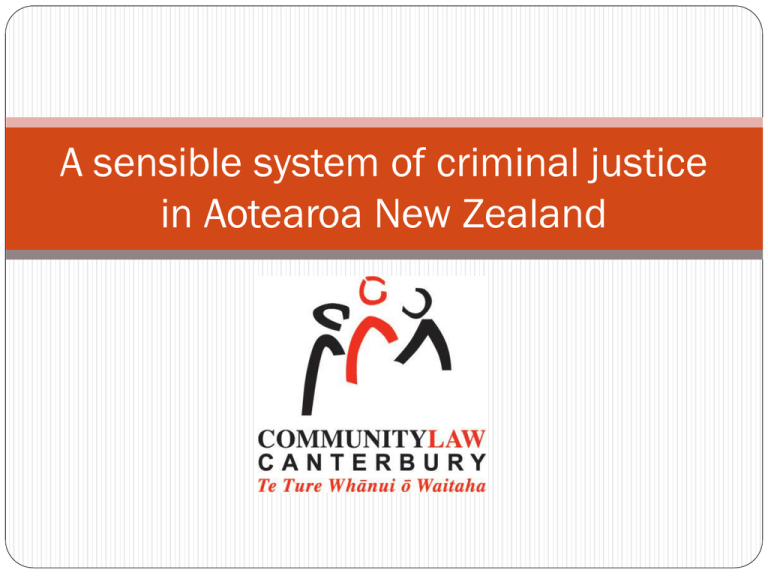
A sensible system of criminal justice in Aotearoa New Zealand Community Justice Panel (CJP) A community-based alternative to the retributive criminal justice system Law vs Justice “Law and justice then are, regrettably, not synonymous terms. The law is not sacrosanct and never should be. What is sacrosanct is true justice, the dignity and equality of people, and respect for the human person over and above every other consideration.” Jim Consedine “Restorative Justice: Healing the effects of crime” Ploughshares Publications, Lyttelton, New Zealand Revised edition 1999, p22 Retributive justice “Retributive justice as we know it views everything in purely legal terms… legal training is trained tunnel vision. In law school you are taught that only legally defined issues are relevant.” Howard Zehir, IARCA Journal, International Association of Residential and Community Alternatives, March 1991 RJ & sentencing – one step forward Sentencing Act 2002, s 8 “In sentencing or otherwise dealing with an offender the court… (j) must take into account any outcomes of restorative justice processes that have occurred, or that the court is satisfied are likely to occur, in relation to the particular case…” “Three strikes” – a giant leap back Recent amendment to the Sentencing Act 2002 (new sections added: 86A – 86I) 40 offences defined as “serious violent offences” Three stage process: Stage 1 & 2 – people convicted of a “serious violent offence” are warned at the time of sentencing Stage 3 (i.e. “third strike”, when convicted of 3rd “serious violent offence”) – High Court must sentence & impose maximum penalty for that offence, in general with no parole. What about judicial discretion? “Three strikes” law retains some judicial discretion in terms of granting parole (s86D(3) Sentencing Act 2002) No parole “unless the Court is satisfied that, given the circumstances of the offence and the offender, it would be manifestly unjust to make that order” (my emphasis) Cf R v Ali (19 August 2004) HC AK CRI-2003-292-1224 Significantly undermines current general discretion: Judge must impose maximum penalty or near to the maximum if offending was or was near to the most serious of cases “… unless circumstances relating to the offender make that inappropriate” Sentencing Act 2002 ss 8(d) and (e) Forever in “Offender Databases” “I’ve spent too much time in jail and I now want help for my alcohol and drug problem. Prison is not helping. There is a lot of good in me you probably don’t know about” A gifted artist I will refer to here as “Joe” Sensible sentencing! “Get yourself off drugs, get into playing league again and get yourself a job, then come back and I’ll sentence you.” Justice Holland (paraphrased of course) Punishment: a counter-productive goal “Punishment has become something the dominant group in society imposes on those of little status and power who are not in a position to challenge its fairness or its usefulness. The political authorities are seen to be doing something about crime, but because what they are doing is counter-productive and actually a cause of more offending, crime rates continue to climb and more and more disempowered people get caught in its net…” Jim Consedine p 19 Adversarial legal system vs logic “… The adversarial legal system spawned by the logic of punishment… is actually destructive of some of justice’s most cherished objectives: the shared sense of what is right and wrong, the holding to account for wrongdoing, the affirming of the importance of the rights of the person injured, the sense of proportionality to the gravity of the misconduct, and the prevention of further harm. (Lorraine Berzins)” Jim Consedine p 19 The restorative model Not “How do we best punish this offender for this offence?” But “How do we best heal the harm caused by this offending?” Crime – simply, when society fails! “Crime comes about when the underpinnings of our culture fail, when the ties that hold us together, socialise our children, and satisfy our needs are broken. Just as the environmental crisis reflects our failure to act in mindfulness of the interdependence of the human species and the other living creatures of the Earth, crime reflects our blindness to the fundamental interconnectedness of people.” Jim Consedine p 18 Justice as right relationships An ecologist at an RJ conference: “I fear our relationship as humans with our environment is in peril. I believe restorative justice is about right relationships between people. I thought, if we are to ever have any hope for getting our relationship with our environment right, then first we must be sure we have our relationships with each other right.” CJPs – a new approach Who? Community law centre! Police Local government (Christchurch City Councillors) Local iwi Kaumatua Judiciary Academics Court staff Ministry of Justice CJP process Assessment at time of arrest If suitable for CJP – offender is released from custody and CJP process explained (CLC provides free advice here) Date set for appearance before CJP (usually three members of offender’s community, pref non-lawyers!) Police prepare info sheet (including reparations, if any, sought) to present to CJP Offender must consent to CJP process & admit guilt (note: admitting guilt also required by ‘Police Diversion’ scheme) Interaction, panel discussion, and an agreement… What a CJP agreement could be CJP could result in an agreement that the offender will: Make payments for damage or loss caused Apologise to victim Undertake a course of action to address why offending occurred in the first place Perform some work for the victim or the community Take steps towards obtaining training or employment Any combination, or all, of the above! CJP objectives Community-based alternative resolution options Personal accountability by offenders Increased victim involvement in resolutions Reducing criminalisation for minor offending and avoiding unnecessary convictions Reducing the demand on Court resources Simplifying police procedures in relations to minor offending Where it’s at In its infancy in Otautahi, Christchurch Pilot programme planned for process to apply only where no information is laid (i.e. not yet under Summary Proceedings Act 1957 s19A(3)) But, could be extended via existing sentencing provisions: A Court is enabled “to determine the most suitable method of dealing with the case.” (Sentencing Act 2002 s25) So Court could adjourn to enable CJP process to occur, then withdraw the information Another forum is now! Restorative justice is long overdue. Our CLC hopes that the Community Justice Panel in Christchurch can be part of the solution. Contact us! Phone Community Law Canterbury reception: (+64 3) 366 6870 Email me: kevin@canlaw.org.nz And of course… If you can’t get legal help anywhere else… we are here to help! Thank you for your time


